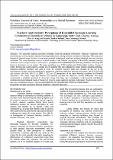Teachers’ and Students’ Perceptions of Kiswahili Classroom Learning Conditions in Secondary Schools in Kakamega North Sub-County, Kenya

View/
Publication Date
2014Author
Maurine Kang’ahi, Francis Chisikwa Indoshi, Tony Omusonga Okwach
Metadata
Show full item recordAbstract/
Abstract: The classroom learning conditions embodies more than physical environment. However, researchers have
overly focused on the physical classroom learning environment leaving out other conditions of learning. This study went
beyond the physical aspect to focus also on environmental, sociological, emotional and psychological classroom learning
conditions. The study objectives were to establish teachers’ and students’ perceptions of Kiswahili classroom learning
conditions and to compare teachers’ and students’ perceptions of Kiswahili classroom learning conditions. The study was
based on descriptive survey design. The target population was 2,520 students and 42 Kiswahili teachers. Yamane’s
(1967) formula was used to derive a sample of 345 students who were selected by simple random sampling technique.
Saturated sampling technique was used to select 38 Kiswahili teachers. Data was collected by the use of the
questionnaire. Overall, the study established a statistically significant difference between the teachers’ (M=3.33, SD=.55)
and students’ (M=3.69, SD=.35); t (380) = 3.93, p= .00 perceptions of the stated learning conditions in Kiswahili
classrooms. The results imply that teachers and students perceive the classroom climate differently. The study
recommends a wholistic approach to classroom design that takes into consideration environmental, sociological,
emotional and psychological needs of students in order to realize optimum learning environment. Teachers also need to
take into consideration learners’ opinions when planning for instruction due to their varied perceptions
